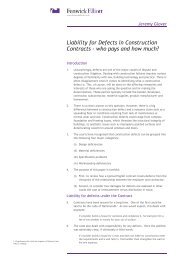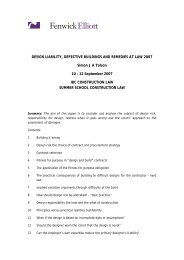Standard forms: JCT 2005, NEC3 and the Virtual ... - Fenwick Elliott
Standard forms: JCT 2005, NEC3 and the Virtual ... - Fenwick Elliott
Standard forms: JCT 2005, NEC3 and the Virtual ... - Fenwick Elliott
You also want an ePaper? Increase the reach of your titles
YUMPU automatically turns print PDFs into web optimized ePapers that Google loves.
<strong>St<strong>and</strong>ard</strong> <strong>forms</strong>: <strong>JCT</strong> <strong>2005</strong>, <strong>NEC3</strong> <strong>and</strong> <strong>the</strong> <strong>Virtual</strong> Contract<br />
www.fenwickelliott.co.uk<br />
The Red Book is used for works that are designed by <strong>the</strong> employer, while <strong>the</strong> Yellow book<br />
is for design <strong>and</strong> build. Ano<strong>the</strong>r important aspect of <strong>the</strong> FIDIC contracts has been <strong>the</strong>ir<br />
adoption by many of <strong>the</strong> international funding agencies, in particular <strong>the</strong> World Bank,<br />
which uses <strong>the</strong> FIDIC terms in its st<strong>and</strong>ard bidding documentation.<br />
In respect of dispute resolution, FIDIC has undertaken a major departure from <strong>the</strong> usual<br />
dual role expected of <strong>the</strong> engineer. Traditionally <strong>the</strong> engineer was retained by <strong>the</strong><br />
employer to design <strong>and</strong> approve <strong>the</strong> works, but at <strong>the</strong> same time fulfil <strong>the</strong> conflicting<br />
role of making engineer’s decision in respect of disputes. This dual role has been<br />
ab<strong>and</strong>oned. The engineer is now seen to be <strong>the</strong> employer’s professional, <strong>and</strong> dispute<br />
resolution is dealt with by way of a DAB, comprising a panel of 3 or a single person (DRA).<br />
Prime contracting<br />
Prime Contracting is <strong>the</strong> Defence Estates approach to adopting <strong>the</strong> recommendations<br />
made not just by Latham but also Egan. The approach utilises a procurement pathway<br />
that integrates <strong>the</strong> supply chain. It is a major departure from <strong>the</strong> Defence Estates<br />
traditional approach to <strong>the</strong> procurement of Projects <strong>and</strong> also <strong>the</strong> maintenance of its<br />
existing stock. Defence Estates deals with property aspects of <strong>the</strong> Ministry of Defence,<br />
<strong>and</strong> its expenditure is in excess of £1 billion per year. It manages a wide range of<br />
property, including not just staff accommodation but also complex airfields, naval bases,<br />
garrisons, defence structures, as well as large tracks of open l<strong>and</strong>.<br />
The key principles behind Prime Contracting involve single point responsibility <strong>and</strong><br />
supply chain management. It does not provide a single st<strong>and</strong>ard form of contract, but<br />
instead provides <strong>the</strong> basis for regional Prime Contracting <strong>and</strong> st<strong>and</strong>alone contracts that<br />
can be developed for a particular major project. Defence Estates is responsible for in<br />
excess of 3,000 individual sites, <strong>and</strong> used to place hundreds of contracts each year. The<br />
purpose of Prime Contracting is to place just 8 major contracts every few years, thus<br />
allowing <strong>the</strong> prime contractor to deal with a large number of sites. Ra<strong>the</strong>r than short<br />
term contracts, a prime contractor will not only deal with a large number of sites but will<br />
also enjoy a contractual period of 7 years (with an option to extend to 10 years).<br />
The philosophy behind this approach is to reduce costs as a result of <strong>the</strong> prime<br />
contractor enjoying economies of scale <strong>and</strong> also to encourage innovation in <strong>the</strong> private<br />
sector by developing <strong>the</strong> supply chain, <strong>and</strong> thus developing <strong>the</strong> principle of shared<br />
profits throughout that chain. In this respect it can be said that Prime Contracting<br />
appears to adopt many of <strong>the</strong> features of a partnering procurement process. In addition,<br />
Prime Contracting apparently adopts many of <strong>the</strong> o<strong>the</strong>r topical approaches such as<br />
industry best practice, life cycle models, <strong>and</strong> value engineering in order to reduce costs,<br />
increase innovation <strong>and</strong> produce a co-ordinated supply chain managed approach.<br />
The “prime contractor” h<strong>and</strong>book for supplying chain management, (1999) defines Prime<br />
Contracting as:<br />
“Prime Contracting is a systematic approach to <strong>the</strong> procurement <strong>and</strong><br />
maintenance of buildings. It draws on <strong>the</strong> best available tools, techniques<br />
<strong>and</strong> practices, including through-life costing, supplying chain to management,<br />
value engineering <strong>and</strong> risk management to achieve efficiency of <strong>the</strong> completed<br />
building.”<br />
19

















